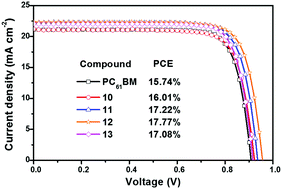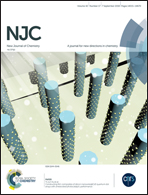New thiophene-based C60 fullerene derivatives as efficient electron transporting materials for perovskite solar cells†
Abstract
The synthesis of new C60 fullerene derivatives functionalized with thiophene moieties as well as with electron donating or electron withdrawing groups, bromine (Br) or cyano (CN), respectively, using Bingel reactions is reported. The synthesized derivatives were used as the electron transporting materials (ETMs) in inverted perovskite solar cells (PSCs). Compared to devices fabricated with [6,6]-phenyl-C61-butyric acid methyl ester (PC61BM), the new derivatives showed similar electrochemical properties and electron mobilities. However, PSCs based on the new derivatives synthesized in this work exhibited higher power conversion efficiencies (PCEs) than PC61BM based devices, which were ascribed to their better passivation ability, likely due to specific interactions between the fullerene addend and the perovskite layer surface. Devices based on the fullerene bearing the CN group exhibited an additionally improved efficiency due to the increased dielectric constant (εr) of this derivative. These results show that the new functionalized fullerene derivatives can act as efficient ETMs in inverted PSCs.



 Please wait while we load your content...
Please wait while we load your content...
